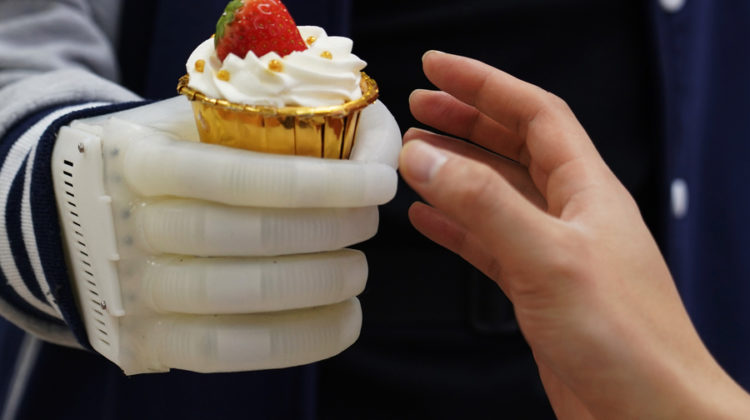
Engineers at MIT and Shanghai Jiao Tong University have designed a soft, lightweight and potentially low-cost neuroprosthetic hand that offers real-time tactile control to amputees.
Neuroprosthetics – highly articulated bionic limbs that have been engineered to sense a user’s residual muscle signals and robotically mimic their intended motions – typically cost thousands of pounds. Built around metal skeletons, they feature electrical motors that can be heavy and rigid. In contrast, the new ‘smart hand’ is soft and elastic, weighs about 225 grams, and is built from components that cost a total of about US$500.
Amputees who tested the new artificial limb were able to perform daily activities, such as zipping up a suitcase, pouring juice from a carton and petting a cat as well or better than those using more rigid neuroprosthetics.
‘This is not a product yet, but the performance is already similar or superior to existing neuroprosthetics, which we’re excited about,’ said one of the team members, Professor Xuanhe Zhao. ‘There’s huge potential to make this soft prosthetic very low cost, for low-income families who have suffered from amputation.’
The prosthetic, which is made from a soft, stretchy commercial elastomer called EcoFlex, comprises five balloon-like fingers, each embedded with segments of fibre that are similar to the articulated bones in actual fingers. These bendy digits are connected to a 3D-printed ‘palm’ shaped like a human hand.
A simple pneumatic system precisely inflates the fingers and can bend them in specific positions. The system, which features a small pump and valves, can be worn at the waist, significantly reducing the prosthetic’s weight.
After developing a computer model to relate a finger’s desired position to the corresponding pressure a pump would have to apply to achieve that position, the team developed a controller that directs the pneumatic system to inflate the fingers in positions that mimic five common grasps, including pinching two and three fingers together and cupping the palm.
The pneumatic system receives signals from so-called electromyography sensors, which measure electrical signals generated by motor neurons that control muscles. The team used an existing algorithm that ‘decodes’ these signals and relates them to common grasp types to program the pneumatic system’s controller.When an amputee imagines undertaking a particular action, the sensors pick up the residual muscle signals and the controller translates them into corresponding pressures. The pump then applies those pressures to inflate each finger and produce the intended grasp.
In order to enable tactile feedback, a feature typically lacking in commercial neuroprosthetics, the team stitched pressure sensors to each fingertip. When the sensors are wired to a specific location on an amputee’s residual limb, the user can ‘feel’ when the prosthetic’s thumb is pressed, for example, versus the forefinger.
The research has been published in Nature Biomedical Engineering.


